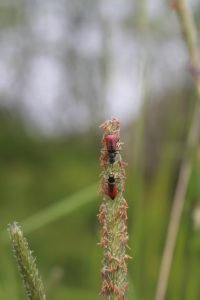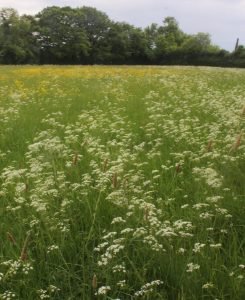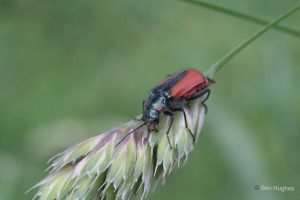The Scarlet Malachite Beetle
What Is The Scarlet Malachite Beetle?
Flighty and small with red and metallic green colouring, the scarlet malachite beetle is one of Britain’s rarest and most threatened insects. It is about 1cm long and visits flowers and grass heads from late April to July. Opening its delicate red wing-cases, it unfurls its long gossamer wings and lifts off gently whilst rapidly accelerating to speeds beyond its apparent ability. It flies easily but usually for short distances close to the flower tops.
Scarlet Malachite Beetle Behaviour
Approaching this beetle is a treat in shy behaviour, a language that extends across species. At two metres away it ignores you and goes about its business. Take a step closer and the beetle turns away from you but looks over its ‘shoulder’ in a ‘Girl with the Pearl Earring’ kind of pose. A step closer still and it hides behind the flowerhead or stem that it’s on and then peeps from behind it. A male may fly away at this point but a female in a position she values may hold-fast and just scotch round to the other side as you circle her or turn the stem to face you. If you are an introvert, like me, you’ll empathise with this beetle.
The adult beetles often gather in loose groups with each female occupying a valued grass head and the males flying between them. There is a courtship ritual (involving pheromones and a chemical exchange) in which the male and female seem to kiss, knock their heads together and lock their antennae together like rutting deer.

Where are scarlet malachite beetles found?
These beautiful beetles were once widespread in Britain but are now restricted to just five known places. Only two of these seem to have strong populations. We cannot reveal the locations as they are small and vulnerable.
The beetles feed on common grasses and flowers. They eat mostly pollen but females at least will eat other insects (to fuel egg-production) and can eat a fly as large as themselves. They are usually seen only as adult beetles in mid-summer using the sunniest patches of grassland.
Scarlet Malachite Beetle Larvae
The young or larvae live hidden away from the breeding meadow in dry vegetation including grasses, reeds dry wood, but here it gets more complicated.
They seem to be dependent on the presence of thatch – the thatched rooves of buildings. This is possibly because the habitat is protected from birds by mesh and from shrews by height. The density of the material also provides protection from predators and curious naturalists and a protected food supply; a win-win situation for these agile, fast-moving, wriggly, long-bodied little pink grubs. The young hatch soon after the eggs are laid, feed and grow through the autumn and winter and then in a final moult become a pupa two weeks before emerging as an adult beetle and returning to the meadow where their parents bred the summer before. Having emerged as adult beetles they live for just that one season, breeding, laying eggs and dying. The longest lived individual so-far lived for 49 days in our flowery enclosure.
Why are we involved in its conservation?
I was asked by Natural England and Buglife to look into captive breeding scarlet malachite beetles and finding out more about how they live. We’ve had success with other captive breeding programmes in the past. The aim was to try to halt their decline and then bring them back to a healthier status. I set out with no knowledge of it beyond its habit over visiting flowers and grasses which seemed to always be near thatch. I attempted to prove or disprove a selection of hypotheses I’d developed from that and answer questions which might help us halt the decline. Critically the prime questions were: What does breeding success depend on and what wipes populations out.
Why is the scarlet malachite beetle declining?
Now people talk of smoking guns and in his fabulous book about passenger pigeons – A Message from Martha – Mark Avery pitched the four horsemen of apocalypse idea which I really, really like. There is seldom one reason for decline or extinction.
There may be many factors involved in the decline of the scarlet malachite beetle. Many insects and other species are much scarcer than they once were due to agricultural chemicals, other pollution and climate change. So, that’s two smoking guns which could finish off a delicate beetle as if in a cowboy western shoot-out. However, the scarlet malachite beetle seems to be particularly prone to interuptions in its life cycle due to land management such as the early cutting (Horseman number 3?) of meadow hay and grass verges and a decline in flower rich hay meadows.
Scarlet malachite beetles and thatch
This problem is all the worse for the fact that the beetles need thatch or some other similar dry vegetation to breed in (possibly out of reach of shrews and other ground dwelling predators). Also the combination of suitable meadow alongside suitable thatch has simply become more and more scarce (horseman number 4 possibly riding side-saddle?).
Changes to thatch, the addition of chemical treatments and a decline in its use on hay ricks, walls and other structures adds to the problem (a fifth horseman is kicking the species when its already down!). It is difficult to get a grip on the complexities of thatch as a habitat because we cannot enter it without destruction, but we know other materials, such as, dead wood sometimes work. So I eventually attempted to dodge thatched buildings and just look at materials. Furthermore, scarlet malachite beetles, as they are now, are reluctant (or unable) to fly far, so when a population is wiped out the old habitat is unlikely to be re-populated. One by one, the populations have disappeared from our countryside almost unnoticed by people fairly innocently ‘tidying up’. With six apocalyptic horsemen hunting it down and smoking guns a plenty, it doesn’t seem surprising.

What we’ve done so far
We started an ecological study of the beetle in 2012 – as intense as we could manage or afford. Observations indicated that the populations we were studying were all near to thatched buildings. Sites where the beetle had become extinct also had thatched buildings. We needed to examine to see if the decline in suitable thatched structures was contributing to the decline of the beetle. Was it really dependent on thatch?
Detective work
We tried a process of elimination by examing soil and grass samples where the beetles were most common. Attaching netting to thatched rooves close to where the beetles were found to see if we could detain one; we didn’t! Next we erected emergence traps on the meadow where the beetles were most common and searched wood from hedgerows. We erected flight interruption nets to see if beetles would be stopped by them between thatch and meadow. Not one was but lots of other insects formed a crowd on the netting. We released beetles we caught to see how they flew and where to. We beat and brushed the thatch as hard as we dared to see if a grub would fall out; it didn’t. I hoovered lofts at all possible locations to see if I could suck up a larva or pupa; I couldn’t.
To test if the netting on thatch was a viable way of ‘detaining’ beetles my son crawled into a terylene cage and released beetles from a pot with only a tiny hole as an exit. We expected the beetles to blunder around like flies on a window trying to find a way out, but they flew without hesitation to the gap and out! Similarly beetles in my darkened hotel room would fly straight to the bedside light. It looked highly likely that scarlet malachites were not going to be fooled by my netting but, by elimination of all materials we could open up, it seemed that they could only be coming from the thatch.
What the Home Owners found
The house owners had reported occasional beetles indoors. It seemed unlikely they would fly into a building as they were so good at flying towards light. So I asked the house owners if they would mind keeping all doors and windows shut until a heatwave came and the beetles emerged. Would any beetles appear indoors? If they did I would be pretty sure the beetles had come from inside the buildings; they did. Added to which one home owner was climbing into bed and a small pink grub landed from above, with plop, on her reading book. Surely it came from the roof. It vanished, but she managed to get a photo with her mobile phone.
The Thatcher!
As Sherlock Holmes said; “Once you eliminate the impossible, whatever remains, no matter how improbable, must be the truth.” But was it!? Had we really narrowed it down to the thatch being the reason that they hadn’t been found? To test this out and to avoid risk of damage to nearby thatched buildings, we decided to create and build mini thatched cottages. These we could get into without being sued for property damage. Watching me thatch, and no thatcher would grant it such a title, is as hilarious as watching someone being chased by wasps. To cut a long story short I invented my own way of upside down thatching! I then turned it the right way up – not something you could do with a house roof.
 These small thatched units were positioned near to locations where the beetle had been seen and where they would serve a purpose. The beetles had a long way to go to suitable meadow and a long journey back to the thatch. With the addition of hungry swallows hurtling through the hypothetical beetle flight paths in between. I’m delighted to say that we have found small pink grubs in the cottages. These were reared to maturity and emerged as adult scarlet malachite beetles.
These small thatched units were positioned near to locations where the beetle had been seen and where they would serve a purpose. The beetles had a long way to go to suitable meadow and a long journey back to the thatch. With the addition of hungry swallows hurtling through the hypothetical beetle flight paths in between. I’m delighted to say that we have found small pink grubs in the cottages. These were reared to maturity and emerged as adult scarlet malachite beetles.
Ongoing
I am now working with land owners to manage scarlet malachite beetle habitat in order to find out more about their needs. The work the land owners have conducted to help the beetle is so good and so generous it brings tears to my eyes. The farmer has extended his field boundaries throughout the beetle’s range. He has also donated a corner of the field to the beetles which is now a mini-meadow. This connects the original thatch more closely to the original meadow; a stepping stone. In it stand our first two beetle nurseries and we now get the highest beetle counts in this area.
The meadow owner has allowed beetle nurseries to be erected in meadows where the beetle is and where it isn’t! They have also altered their garden to suit scarlet malachite beetles.
How can it be saved?
I believe the scarlet malachite beetle can be saved by:
- Late mowing of meadows and verges around thatched buildings.
- Keeping areas of meadow and thatch completely free from the shade of trees and buildings where beetles are known to be
- Where possible making sure that the ‘nursery habitat’ (thatch or similar) is as close as possible to the breeding habitat.
- Taking care not to use chemical treatments on thatch that might be harmful and by not re-thatching all available buildings at once
- Known scarlet malachite habitats could be supplemented with our thatched nursery cottages. Reserves willing to take a population of beetle could use our cottages as stand alone breeding units.
- There are other species needs to consider but, wherever possible and appropriate, village greens could adopt a scarlet malachite beetle friendly approach and re-light the lights extinguished by those apocalyptic horsemen! Sunny meadows and less mowing; butterflies and wildflowers, what’s not to like?
It seems unlikely that the populations can recovery quickly by spreading naturally unless suitable places are very close together. So translocation of beetles or grubs seems the most likely way to effectively recover lost or new populations.
Why Thatch?
The most commonly asked question is: how can a wild beetle have become dependent on thatch and what is the natural alternative?
Well…Thatch is natural it’s just that humans do it too and on a large scale.
Un-managed grasslands can form dense tussocks along with a much greater variety of plant species, including sedges and hollow stemmed plants. These may have supplied suitable habitat.
There was once a time when what we consider crops, meadows and pasture were not distinguishable. Each were just natural grasslands with dead grasses mixed in plus an occasional tree or dead branch. In amongst that would have been the faeces and carcasses of animals, from mammoths downwards in size, which may have provided larval habitat.
A mammoth or a wild bull or bison produced great dollops of faeces that would be interwoven with grasses and heave with insects. The piles can seal over with a waterproof lid. This can easily endure for the year it takes a scarlet malachite beetle to mature. The dead bodies of these animals, if not butchered by humans have rib-cages that could last a long time. With a covering of dry skin and hair, these would contain many insects and act quite like a thatched roof.
What has changed about the country side?
Our country has seen the disappearance or decline of many ground nesting birds, such as skylarks and corncrakes. This is as well as the disappearance of larger thatchers such as beavers and storks whose nests may be suitable habitat
Hollow trees and fallen branches are much scarcer than they once were. We know scarlet malachite beetle can grow to maturity in wood piles (although it doesn’t seem enough to sustain a population). If English elms were still around they may have provided habitat. Elms as full sized trees disappeared from the countryside in the 1970s due to dutch elm disease. They were notorious for occasionally shedding large branches and their wood was particularly water resistant.
If the British weather has become gradually wetter, it is possible that other habitats that are now too damp were once suitable for scarlet malachite beetles. Introduced beetles in North America seem to survive in the absence of thatch.
Humans have been thatching for over 10,000 years in Europe. Many other species have adapted to human dwellings so it is not so surprising that a beetle might.
If one or all of the options above provided suitable habitat for scarlet malachite beetles, then we have a link at least to a more natural larval habitat.
The Importance of Insects to our eco-systems
The scarlet malachite beetle is just one of an immense number of insects native to our countryside. Some are common some are rare but all are important. Insects are important for pollinating the crops and trees that give us our food, wood and other products.

Wasps have a bad reputation with outdoor snackers, but are useful pollinators. They eat other insects and should really be called the gardeners or farmers best friend. Many other insects including ones that may bite us are important food for birds and bats. As larvae they may be food for fishes and amphibians. So while we wouldn’t encourage you to truly love stinging and biting insects, it is worth finding out what else they do before taking further action! Flies are considered dirty and they do carry disease, but they also do a very useful job of clearing up poo and dead animals. They also provide food for some of the most notably beautiful birds such as robins and blue-tits, but even rarer giants like ravens eat maggots.
The ancient Egyptians worshipped the scarab beetle because they saw its importance in burying dung and enriching croplands. I extend that level of respect to the insects which keep us alive and our planet beautiful.


